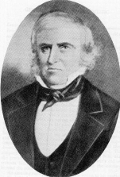The Making of the 50 States: Utah
Part 1: In the Beginning The Anasazi and Fremont cultures lived in what is now Utah early in the first millennium A.D. Among the Native American tribes living after them were the Goshute, Navajo, Paiute, Shoshone, and Ute. 
Spanish explorer Juan Maria Antonia Rivera came to Utah twice in the 1760s. He is the first known European to see the Colorado River. In 1776, Spanish missionaries Silvestre Velez de Escalante and Francesco Atanasio Dominguez explored Utah on their way to California. When Mexico won its independence from Spain in 1821, the ownership of Utah changed from Spain to Mexico. The American victory in the Mexican-American War in 1848 made Utah American territory. In between, Utah was home for a time to explorers like William Henry Ashley, Jim Bridger, John C. Frémont, Miles Goodyear, Peter Skene Ogden (right), and Jedediah Smith. A more infamous expedition came through in 1846. The Donner-Reed party had traveled on the California Trail but took what they thought would be a shortcut through the Great Salt Lake Desert. They encountered harrowing conditions, and many of the party died. 
Utah's Salt Lake Valley was the destination of Brigham Young and a number of other Mormons, members of the Church of Jesus Christ of Latter-day Saints, in 1847. That was the first of many migrations of Mormons to Utah. The number would eventually be tens of thousands. A constitutional convention in 1849 resulted in a proposal to Congress for the creation of the State of Deseret (a reference from the Book of Mormon). Congress, rejecting the name, established the Utah Territory in 1850, with Fillmore the capital and Brigham Young the governor. Under the Compromise of 1850, the Utah Territory also had the right of Popular Sovereignty, for people to vote on whether their territory would allow slavery. Slavery was legal for a time in Utah. The first pioneers brought African slaves with them. Two laws recognizing slavery passed in 1852; ten years later, Congress outlawed slavery in all U.S. territories. In 1857, a dispute over who would be the territorial governor descended into an armed conflict between Mormons and non-Mormons. President James Buchanan informed Brigham Young that he was no longer governor; then, Buchanan, fearing violence, sent 2,500 members of the U.S. Military under Albert Sidney Johnston to help install the new governor, Alfred Cumming. The Mormon War, as it became known, involved thousands of troops and resulted in some acts of violence, but no deaths occurred and the conflict ended with a diplomatic solution. 
Silver and lead were discovered in Bingham Canyon in 1863. As in other western states, settlement increased as people came to Utah seeking their fortunes. Also as in many other states, an increase in settlers resulted in an increase in conflict with Native Americans. One of these, the Black Hawk War, was the most destructive conflict in territorial history. It raged on and off from 1865 to 1872; involved about 150 battles, skirmishes, and raids; resulted in the deaths of several dozen people on both sides; and did large amounts of damage to settlements and livestock. Next page > The Rest of the Story > Page 1, 2
|
|
Social Studies for Kids
copyright 2002–2024
David White




